Dezember 2017
EUCLID: ESA-Project to Search for Dark Matter and Energy takes Crucial Step
HPS Germany receives STM-acceptance for first model of the central antenna unit
European HPS-Group first Enterprise to Receive EN 9100:2016-Certification
Juli 2016
Quality first beyond borders
Letterheads, websites, publications: The claim of the midsize European space company is everywhere: „HPS – The Team to Trust“. Since June 27th now, this claim is even officially backed by the award of the first certification according to the strict rules of the brandnew „DIN EN 9100:2016 Aviation, Space, and Defence Quality Management Services.“ Not only that HPS, headquartered in Munich, is the first company ever in Germany to receive this high ranking confirmation – it is also a breakthrough for the whole group, because the certificate covers all of its three European group members, in Germany, in Porto (Portugal) as well as in Bucharest (Romania).
The certification was performed by the certification body AirCert GmbH, based in Ottobrunn near Munich (www.aircert.org), operating all over Europe and even overseas and in the far East. AirCert has specialized for the high end aerospace business and consequently made a big effort to be one of the very first entities in Germany to become authorized by international authorities for the new EN9100:2016 standard.
While the certification audit took seven working days to clearly review that the space group guarantees the same highest possible quality-management at all sites beyond borders, the preparations for this next great step after the certification of HPS in Germany and Portugal according to the 2008-rules of ISO 9001 took more than one year and an investment well above 100,000 Euros. The new EN9100 certification rules are by far more detailed and specific about the specification of core processes, traceability of supply chains and working processes, strict in the area of management processes and explicit about the requirements on key performance indicators, facilities, tools, and equipment as well as on awareness and compliance – the latter bearing the undeniable proof that the European space business world can serve as a shining example of sharing the same values when it comes to serving the customers with quality first.
„HPS- The Team to Trust“ – rarely has a space company´s communication claim been more seriously substantiated.
HPS being awarded the Q/V band antenna project FLANT
February 2012
The objective of the project is to develop a high-performance Q/V-band Earth deck antenna for broadband feeder link application. The baseline antenna will be designed and analyzed at RF, mechanical and thermal levels, supported by critical bread boarding when necessary. An Engineering Model of the selected antenna will be manufactured and tested.
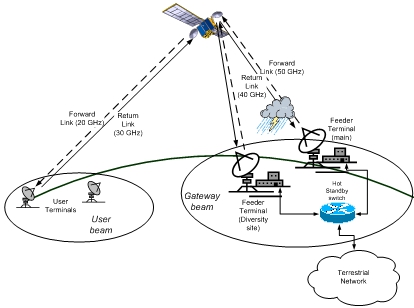
HPS at German Congress on Satellite Communications
March/April 2012
HPS was attendee, exhibitor and held speeches on the German national conference about satellite communications. The topics of the HPS speeches were:
- Q-V-Band applications
- Q-V-Band antenna structures
- High Tech and latest technology for Ka-band antennas and reflectors.
- The shown model is our full CFRP STANT antenna (environmentally tested and RF tested in Ka-/Q-/V-band).
More information on the congress can be found on the DLR homepage.
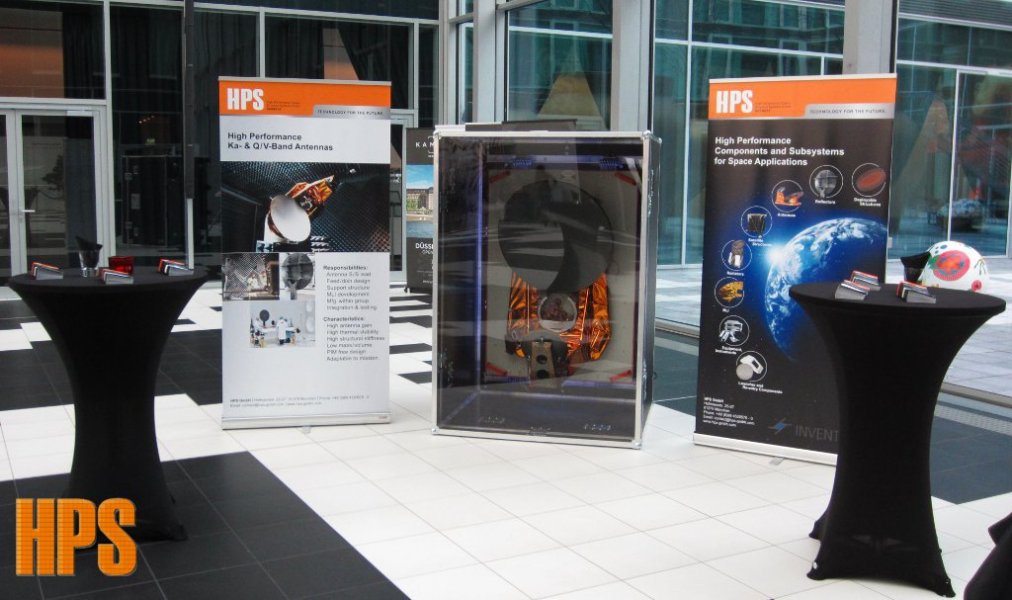
Successful PIM campaign at ESA-VSC High Power RF Laboratory
September 2012
In the frame of a German national project called HISST a comprehensive (research) PIM test campaign has successfully been conducted. Not only the verification of HPS reflector technology concerning PIM but also a comprehensive material and design research was essence and purpose of this campaign.
Key facts:
- frequencies in Ka-band
- PIM order: 7th, 9th, 11th and 13th were investigated
- material samples, breadboards and reflector models were tested (more than 60 tests overall)
- Mostly CFRP parts but also future space materials
- HPS PIM mitigation measures analysed.
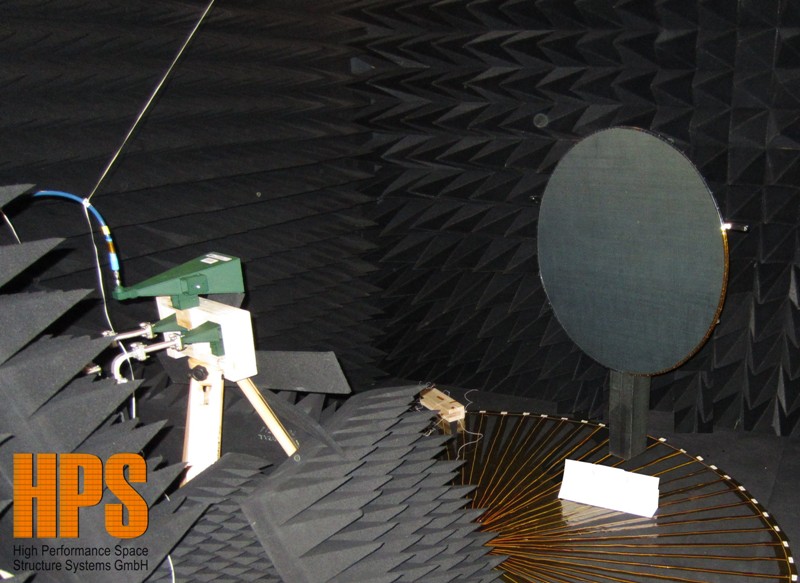
Successful vibration and acoustic campaign of 1.6m Ka-band reflector
October 2012
The vibration and acoustic test campaign has been finished successfully. The reflector is a 1.6m side deployable Ka-band reflector featuring novel technologies and a full CFRP design. It is a collaborative development with Invent (manufacturing) and Technische Universität München (testing technologies and material science) as well as HPS being reflector subsystem responsible, project coordinator and being in charge of design and analyses.
Key tests among other test runs at IABG were:
- sine vibration qualification loads
- random vibration qualifications loads
- acoustic qualifaction loads.
Test to be performed:
- Thermal vacuum cycling.
Key facts of reflector:
- Ka-band
- 1.6m aperture
- GEO application (Tx/Rx)
- full CFRP
- ultra stiff (first eigenfrequency at approx. 130 Hz)
- reflector structural mass approx. 9 kg (even lower mass is possible)
- extremely low thermal-elastic distortions thanks to full CFRP design.
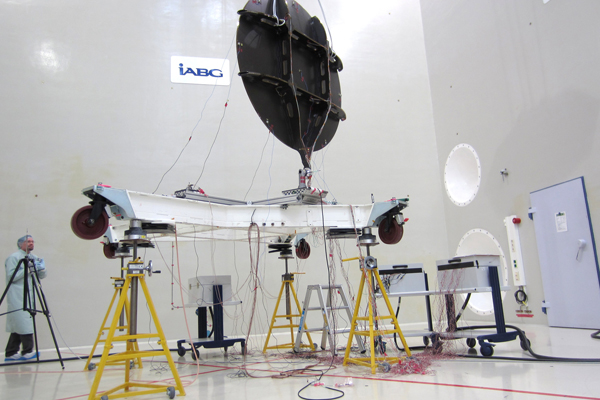
Münchner Weltraumschmiede HPS: Kleidung für Satelliten
December 2012
Im Weltraum ist es kalt – und heiß. Satelliten, die beispielsweise aus 36.000 Kilometern Höhe über der Erde ihre Fernsehprogramme abstrahlen, sind auf der Sonnenseite Temperaturen von plus 120 Grad ausgesetzt, während auf der anderen Seite die Kälte des Alls mit minus 170 Grad an ihnen nagt. Ausgeglichen wird diese Differenz durch eine maßgefertigte weltraumtaugliche „Daunenjacke“, den Thermalschutz (im Fachjargon: MLI, Multi-Layer-Insulation).
Allein etwa eintausend kommerzielle Satelliten im Wert von über dreihundert Milliarden Euro sorgen weltweit für Telefon-, TV- und Datenübertragung. Dazu kommt noch eine Vielzahl von wissenschaftlichen Satelliten, die in die Ferne spähen oder die Erde beobachten. Für ihre angemessene „Bekleidung“ und damit Funktionsfähigkeit sorgte in Europa bislang vornehmlich ein großer Hersteller aus Österreich, dessen Marktherrschaft seit neuestem die kleine Münchner Raumfahrtschmiede HPS mit deutlich niedrigeren Kosten bei zertifizierter gleicher Qualität attackiert. Das Rezept: Die Forschungs- und Entwicklungszentrale in Deutschland hat nach fünf Jahren Vorbereitung ihre Tochtergesellschaft in Porto zum Produktionsstandort qualifiziert und ausgebaut; Die Entwicklung der Schnittmuster, Nähverfahren und Halterungen wird durch Spezialisten hauptsächlich in Deutschland durchgeführt.
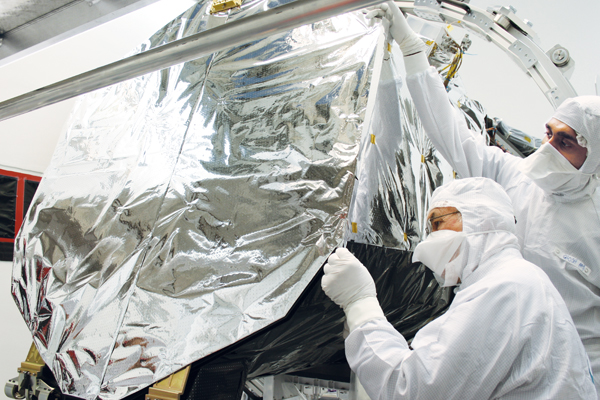
In den vergangenen Wochen wurden die letzten Maßanfertigungen des Thermalschutzes für das drei Meter hohe Weltraumteleskop „eROSITA“ des Max-Planck-Instituts für extraterrestrische Physik in Garching bei München angelegt: Insgesamt rund 80 unterschiedliche Kleidungsstücke mussten für die hochgenaue Struktur entwickelt werden. Das Teleskop wird ab 2014 an Bord des „Spektrum-Röntgen-Gamma“ – Satelliten erstmals den gesamten Himmel auf der Jagd nach „Dunkler Materie“ kartographieren. „Das eROSITA-MLI ist der bisherige Höhepunkt unserer erfolgreichen Entwicklung und Fertigung. Im Oktober haben wir zudem gerade eine Garderobe aus ca. 120 Teilen für das Landungsraumschiff der kommenden ESA-Mission zum Mars begonnen, und für rund ein halbes Dutzend weitere Satelliten-Thermoanzüge erwarten wir den Zuschlag. Daneben sehen wir unser Potential auch in unzähligen kleineren Aufträgen für Satelliten-Unterlieferanten, die vom Marktführer bisher aus unserer Beobachtung nicht optimal bedient werden. Unser Angebot bietet nicht nur den Kunden eine Alternative zum bestehenden ´Monopol´; es zeigt auch, welche Chancen in Europa für grenzüberschreitende Unternehmungen gerade im Hochtechnologie-Bereich Raumfahrt bestehen. Die derzeit zwölf Arbeitsplätze im krisengeschüttelten Portugal sind sicher, fünf bis zehn weitere kommen bald hinzu; in Deutschland werden wir parallel von 30 auf 50 Mitarbeiter wachsen“, so der HPS-Chef und Raumfahrtingenieur Dr. Ernst K. Pfeiffer. Kunden sind neben der europäischen Raumfahrtagentur ESA (Paris) und der deutschen Raumfahrtagentur DLR (Bonn) Unternehmen wie die OHB-Tochter Kayser-Threde (München), ThalesAleniaSpace Italia (Turin) und das Max-Planck Institut für extraterrestrische Physik (Garching).
Heinrich Hertz North Beam Antenna Reflector – H2KAR-PDR
May 2013
H2KAR reflector
The objective of the H2KAR activity is to produce, assemble, integrate, test and verify a full CFRP antenna reflector PFM for a German GEO orbit communication mission (Ka band). This reflector makes use of several innovative technologies being developed by HPS and its partners.
The aim of developing these technologies at HPS and partners is meeting future spaceborne antenna requirements. In order to obtain a space qualified product the final step is the demonstration of successful on-orbit operations, also known as in-orbit verification/ validation (IOV). This is the point where novel HPS antenna technologies meet the German mission called H2Sat because one of its missions purposes is bringing new technologies into orbit.
H2KAR phase B was launched in October 2012. Some preliminary key characteristics of the reflector are:
| Orbit | GEO |
| Type | Single offset side deployable |
| Frequency | Ka band |
| Aperture | Approx. 1.0m |
| Coverage area | Northern Germany, North Sea, Baltic Sea |
More information on the Heinrich Hertz Mission are found on the DLR website.
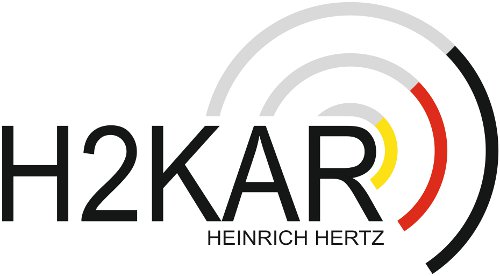
Alphasat launch with HPS MLI being aboard
July 2013
On July 25th the satellite Alphasat was successfully launched by an Ariane 5 launcher. This means, the first HPS and Portuguese multilayer thermal insulation (MLI) was also launched to space. The MLI being on orbit it is also a flight premiere for the whole HPS family. Currently, HPS is designing the MLI for the European Exomars mission.
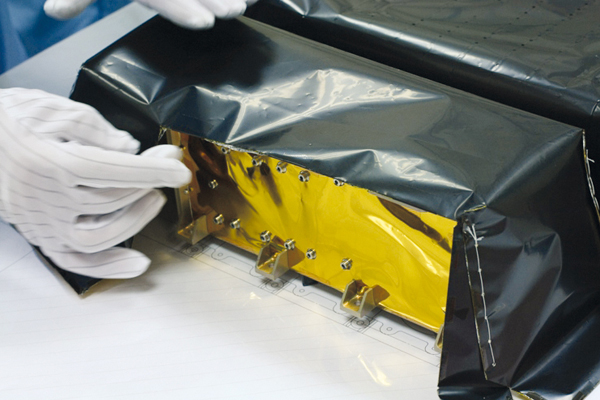
HPS attending SSMET 2014 and EuCAP 2014
March/April 2014

HPS attends to the European Conference on Spacecraft Structures, Materials & Environmental Testing (SSMET) 2014 in Brunswick, Germany. Moreover, serveral publications are subject to oral presentations, i.e.:
- HIGH CONDUCTIVITY CFRP SANDWICH TECHNOLOGIES FOR PLATFORMS
- KUDGR – DUAL GRIDDED CARBON FIBER REINFORCED PLASTIC REFLECTOR
- NON-CONVENTIONAL CARBON NANOTUBE SKELETON REINFORCED COMPOSITES FOR SPACE APPLICATIONS
- SCALABLE – INNOVATIVE SCALABLE LARGE DEPLOYBLE ANTENNA REFLECTOR
- VANESSA – VALIDATION OF NUMERICAL ENGINEERING SIMULATIONS – STANDARDISATION ACTIONS
More information on the congress itself is found by following this link.
Visit our booth at EuCAP!
In addition, HPS attends and presents publications as well as contributes to the exhibition of the 8th European Conference on Antennas and Propagation (EuCAP 2014) in The Hauge, The Netherlands. The publications address the following topics:
- A Q/V-band Antenna for Feeder Link Applications
- An Ultra Rapid Deployable Antenna for on-the-field Satellite Communications
- In-orbit verification of novel reflector antenna technologies – the final step of a European-German development
- RF Design Challenges for a New DGR Concept
More information on the conference itself is found by following this link.
